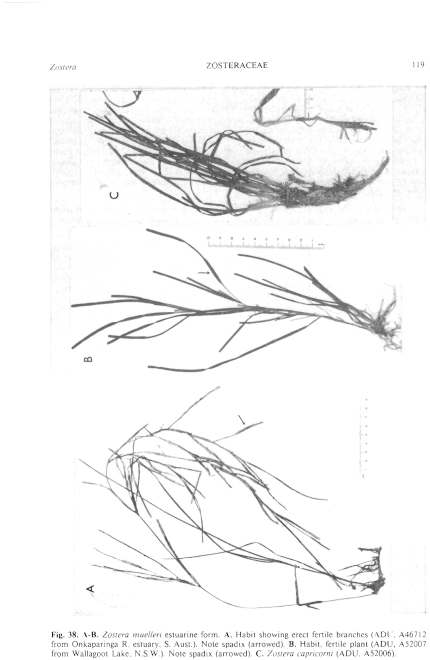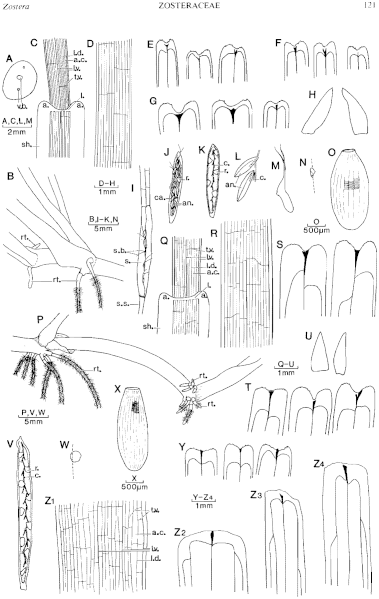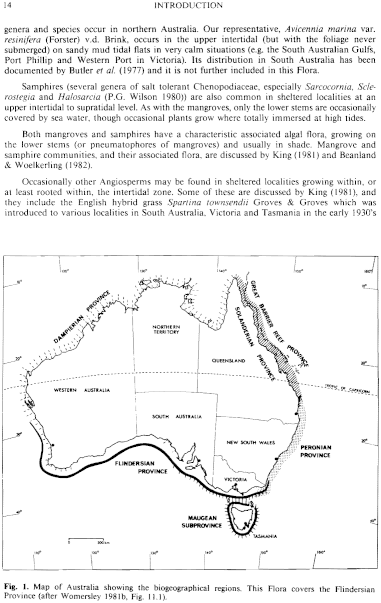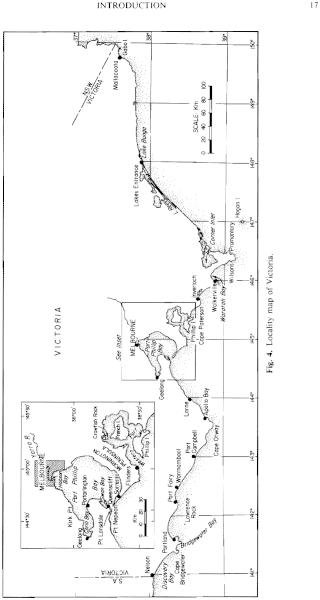|
|
|
|
|
|||||||||||
|
Electronic Flora of South Australia Species Fact Sheet
Phylum Magnoliophyta – Subphylum Seagrasses – Class Liliopsida – Subclass Alismatidae – Order Potamogetonales – Family Zosteraceae
Selected citations: Aston 1973: 330, fig. 137c. den Hartog 1970: 81, figs. 21, 22. Jacobs & Williams 1980: 454. Jessop 1978: 73. Sainty & Jacobs 1981: 426.
Perennial (Fig. 38C) with much-branched rhizomes (0.5–) 1–2 mm thick. Roots arising in 2 distinct groups of 4–8 at each node. Leaf blade linear, 7–25 (–50) cm long, 2.5–5 mm broad, longitudinal veins (Fig. 39Z 1–4) usually (4–) 5, with the intermediate veins usually close to the submarginal ones and well-spaced from the midvein, the submarginal veins usually uniting with the intermediate ones some distance from the apex (so that the apex may appear 3-veined), 6–8 longitudinal air canals on each side of the midvein, transverse veins usually not continuous from one longitudinal vein to the next; apex (Fig. 39Z 2–4) truncate. Squamules lanceolate. Fertile shoot 10–30 (–50) cm tall, sympodially branched, bearing several spadices; spathe linear, spadix subsessile, with a short mucro; male and female flowers 6–10 each per spadix; retinacules broadly triangular, 1.5–2 mm broad, L/B approximately 1. Seed ellipsoid, brown, about 2 mm long, with fine longitudinal striations and numerous very fine transverse striations.
Lectotype from Moreton Bay, Queensland (Naumann, 10.x.1875); in UC.
Selected specimens: Cape Willoughby, Kangaroo I., S. Aust. (Harswill 1305, Sept. 1885; MEL, 3724). Eden wharf, N.S.W., 0.5 m deep (Jacobs 2413 & Williams, 18.xi.1975; ADU, A52006). Towra Point, Botany Bay, N.S.W. 0–0.5 m deep (Robertson, 23.viii.1981; ADU, A52352). Towra Point, Botany Bay, N.S.W. uppermost sublittoral (Robertson, 23.viii.1981; ADU, A52355).
Distribution: Widely distributed from the tropical coast of Queensland to New South Wales and as far south as Mallacoota, Vic. There is one record from Cape Willoughby, Kangaroo I., S. Aust. Also on the coasts of Lord Howe I. and North Island, New Zealand. Z. capricorni usually occurs subtidally to about 7 m deep.
Taxonomic notes: Z. capricorni is generally more robust than either Z. mucronata or Z. muelleri sensu stricto. Robust plants of the estuarine form of Z. muelleri are very similar in growth habit to Z. capricorni.
Z. capricorni is a tropical or warm temperate species and Cape Willoughby, Kangaroo Island is well beyond its normal range. The specimen, collected in 1885, has been examined and its leaf venation and apex shape certainly place it in Z. capricorni. It is not battered as would be expected if it had drifted a long distance. Unless it bears a misplaced label it would appear to be an interesting disjunct distribution. However, the species has not been re-collected from Kangaroo Island, the closest known population occurring at Mallacoota, Vic., 20 km SW of the N.S.W. border.
References:
ASCHERSON, P. (1876a). In Sber. Ges. naturf. Freunde Berl. 1876, 9–12.
ASCHERSON, P. (1876b). In Verh. bot. Ver. Brandenburg 18, 59–60.
ASTON, H. (1973). Aquatic plants of Australia. (Melbourne University Press: Melbourne.)
DEN HARTOG, C. (1970). The seagrasses of the World. Verh. k. ned. Akad. Wet. Afd. Natuurk., ser. 2, 59(1), 1–275 (-1–31 Plates).
JACOBS, S.W.L. & WILLIAMS, A. (1980). Notes of the genus Zostera s. lat. in New South Wales. Telopea 1, 451–455.
JESSOP, J.P. (1978). J.M. Black's Flora of South Australia. 3rd edn. Part I. (Govt. Printer: Adelaide.)
SAINTY, G.R. & JACOBS, S.W.L. (1981). Water Plants of New South Wales. (Water Resources Commission of New South Wales: Sydney.)
The Marine Benthic Flora of Southern Australia Part I complete list of references.
Publication:
Womersley, H.B.S. (31 May, 1984)
The Marine Benthic Flora of Southern Australia
Part I
©Board of the Botanic Gardens and State Herbarium, Government of South Australia
Illustrations in Womersley Part I, 1984: FIGS 38C, 39Z 1–4>.

Figure 38 enlarge
Fig. 38. A–B. Zostera muelleri estuarine form. A. Habit showing erect fertile branches (ADU, A46712 from Onkaparinga R. estuary, S. Aust.). Note spadix (arrowed). B. Habit, fertile plant (ADU, A52007 from Wallagoot Lake, N.S.W.). Note spadix (arrowed). C. Zostera capricorni (ADU, A52006).

Figure 39 enlarge
Fig. 39. A-0. Zostera muelleri sensu stricto. A. T.S. rhizome showing arrangement of vascular bundles (v.b.) B. Portion of rhizome showing 2 roots (rt.) per node. C. Portion of leaf (adaxial view). Junction of blade and sheath (sh.) (opened out) showing ligule (l.), auricles (a.), longitudinal veins (1.v.), transverse veins (t.v.) and longitudinal diaphragms (l.d.) separating longitudinal air canals (a.c.). D. Mid portion of leaf blade showing venation and longitudinal diaphragms. E. Leaf apices (from lectotype). F. Leaf apices (from Swan Bay, Vic.). G. Leaf apices (from Kelso, Tas.). H. Pair of squamules. I. Spathe (s.) with flattened stalk (s.s.), and stigmatic branches (s.b.) projecting from enclosed spadix. J. Spadix (removed from spathe) showing 5 male flowers (anthers, (an.)), 5 female flowers (carpels, (ca.)) and 5 retinacules (r.) in position. K. Spadix (with flowers removed) showing retinacules (r.) and anther connectives (c.). L. Male flower of 2 anthers (an.) and connective (c.). M. Female flower of one carpel with 2 stigmatic branches. N. Retinacule showing line of attachment. 0. Seed showing longitudinal and (in part) transverse striations. (A–D, G–N from ADU, A53901. E from lectotype. F from ADU, A51059. O from ADU, A54000.)
P–X. Zostera muelleri estuarine form. P. Portion of rhizome showing roots (rt.) arising in two groups at each node. Q. Portion of leaf (adaxial view). Junction of blade and sheath (sh.) (opened out) showing ligule (l.), auricles (a.), longitudinal veins (l.v.), transverse veins (t.v.) and longitudinal diaphragms (l.d.) separating longitudinal air canals (a.c.). R. Mid portion of leaf blade showing venation and longitudinal diaphragms. S. Leaf apices (from Onkaparinga R. estuary, S. Aust.). T. Leaf apices (from Mallacoota, Vic.). U. Pair of squamules. V. Spadix (with flowers removed) showing retinacules (r.) and anther connective (c.). W. Retinacule showing lines of attachment. X. Seed showing longitudinal and (in part) transverse striations. (P,R,S,X from ADU, A52695. Q,U from ADU, A52783. I from ADU, A53978. V,W from ADU, A46712.)
Y. Zostera muelleri intergrade between typical and estuarine forms (ADU, A52800 from Port Gawler, S. Aust.). Leaf apices.
Z1-Z4 Zostera capricorni. Z1 Mid portion of leaf blade showing longitudinal (l.v.) and transverse veins (t.v.) and longitudinal diaphragms (l.d.) separating longitudinal air canals (a.c.). (ADU, A52352). Z2-Z4. Leaf apices (ADU, A52355).

Figure 1 enlarge
Fig. 1. Map of Australia showing the biogeographical regions. This Flora covers the Flindersian Province (after Womersley 1981 b, Fig. 11.1).

Figure 4 enlarge
Fig. 4. Locality map of Victoria.

|
Email Contact: State Herbarium of South Australia |

|